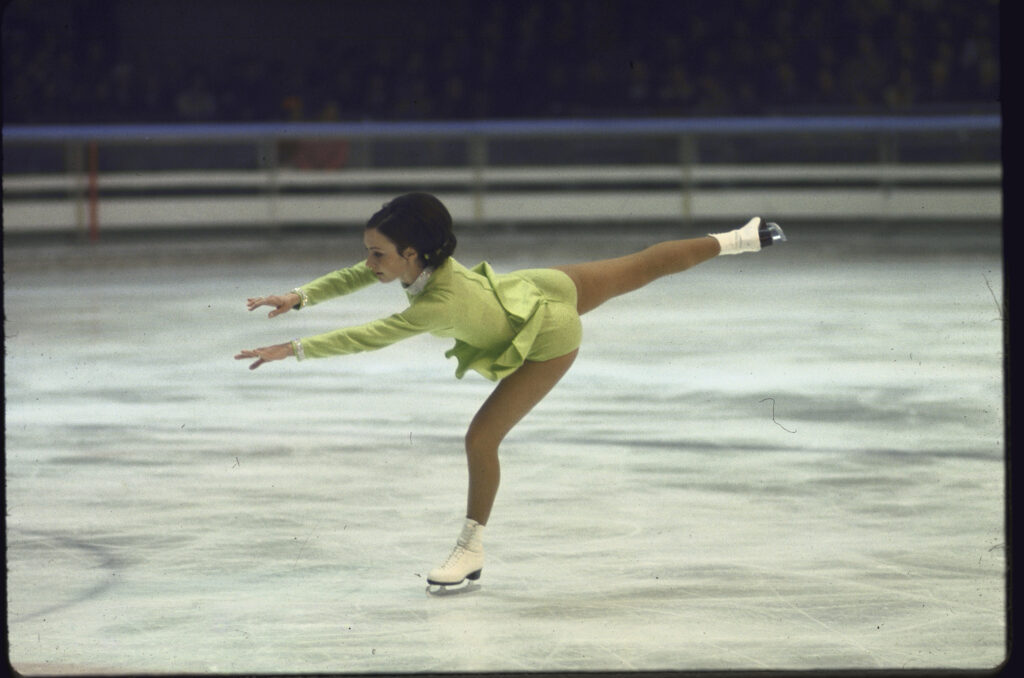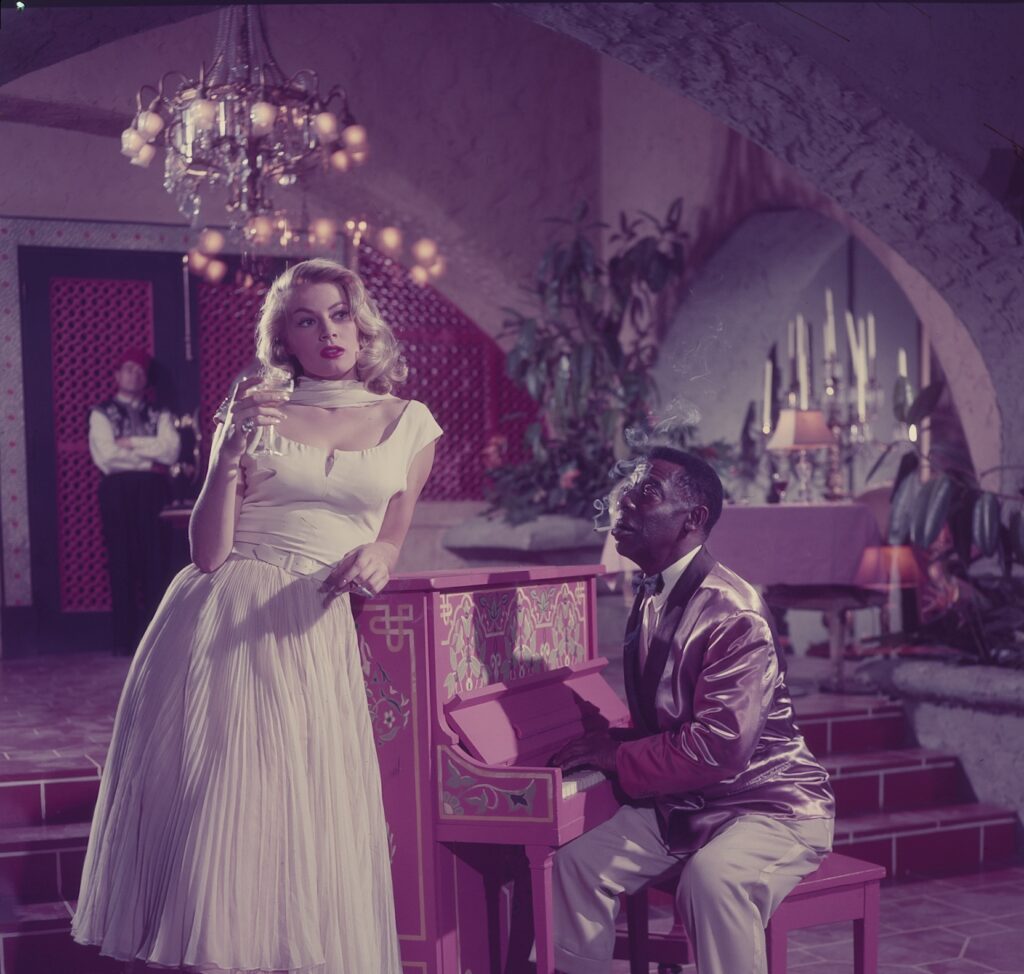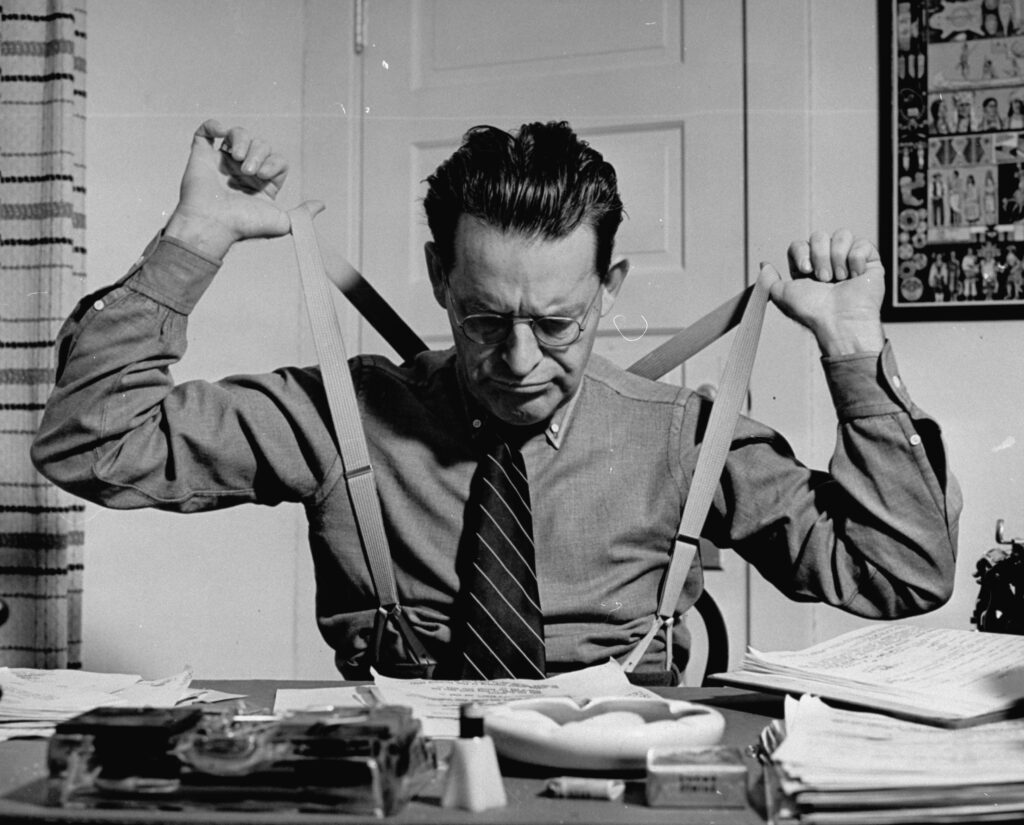Nina Leen’s life, from early on, was one in which travel played a key role a life that, in retrospect, had something of a purposefully nomadic quality. Born in Russia (the date of her birth is unknown, as she adamantly refused to reveal or even discuss her age), Leen grew up in Europe. She studied painting in Berlin before emigrating to the United States in 1939. With her first camera, a Rolleiflex, she honed her photography skills, teaching herself how to take pictures and developing what would become her signature style by creating at-once intimate and stylized portraits of animals at New York’s Bronx Zoo.
In fact, the first pictures she published in LIFE were a series of photos of ancient, combative tortoises (included in this gallery) that she made at the Bronx Zoo and subsequently, at the urging of friends, submitted to the magazine. LIFE published the pictures in its April 1, 1940 issue, launching Leen’s relationship with the preeminent photography magazine of the age. (Interestingly, while she is often described as “one of the first women staff photographers at LIFE,” Nina Leen was never, in fact, officially on the staff of the magazine. Instead, she was a contract photographer who enjoyed an astonishingly long working affiliation with LIFE, one that lasted from the 1940s until the magazine ceased publishing as a weekly at the end of 1972.)
Leen produced a vast and varied body of work during the three decades she shot for LIFE, including more than 50 covers and countless reports and photo essays from around the world. But perhaps the single assignment that had the most lasting effect on her own life and work was actually one on which her colleague Leonard McCombe was the photographer. In 1949, McCombe was covering a story in Texas when he came across a dead dog and its cowering, flea-ridden and filthy but still very much alive puppy.
McCombe, unable to simply abandon the creature, shipped it off to the LIFE offices in New York, where Leen who was well-known for liking animals far more than she liked most humans adopted it. In very short order the dog, dubbed “Lucky,” became America’s pet. Nina brought Lucky with her everywhere, documenting the dog’s post-rescue adventures in follow-up articles, a book (and book tour) and even a short film.
A great animal lover whose pictures of dogs, cats, bats (she had a special affinity for and obsession with the furry flying mammals) and other creatures could, and eventually would, fill entire books, Nina Leen also had a way with those other wild things: teenagers. Her numerous essays on the fads, etiquette and attitudes of the American teen captured the younger generations of the ’40s and ’50s with a winning mix of bemusement and empathy. She was also one of the most prolific and accomplished fashion photographers LIFE ever had, covering Paris shows in the 1940s, for example, with a cool, discerning eye.
That she was not limited to photographing animals and hormonally addled youngsters, however, is evidenced by two of her most famous group portraits: one, a picture featuring four generations of an Ozark family (selected by Carl Sagan to fly aboard the Voyager space probe as part of a message, of sorts, to any extraterrestrial civilization who might intercept the spacecraft); the other a photo of “The Irascibles” a now-legendary group of artists including de Kooning, Pollock, Rothko and others who protested the Metropolitan Museum’s refusal to include Abstract Expressionist works in a major 1950 retrospective of American painting.
After LIFE folded (for the first time) in 1972, Nina Leen’s career hardly slowed. Throughout the 1970s she produced an average of two books a year, and published 15 in her lifetime, including a groundbreaking work on her beloved bats. Nina Leen died on January 1, 1995, at her home in New York City. A spokesperson for LIFE said that she was in her late 70s or early 80s but no one really knows for sure.
Liz Ronk edited this gallery for LIFE.com. Follow her on Twitter at @LizabethRonk.

Lucky from the movie, “The Lost Dog,” 1955.
Nina Leen/Life Pictures/Shutterstock
![Tommy Tucker, a squirrel, was dried after a bath. He seemed to like being rubbed briskly. Although Tommy was neat about his own person, Mrs. Bullis, the woman who dressed him in clothes that she herself designed and made, had never been able to housebreak him, 1944. Tommy [Tucker, the squirrel] is dried after a bath. He seems to like being rubbed briskly. Although Tommy is neat about his own person, Mrs. Bullis [the woman who dressed him in clothes that she herself designed and made] has never been able to housebreak him.](data:image/svg+xml,%3Csvg%20xmlns='http://www.w3.org/2000/svg'%20viewBox='0%200%200%200'%3E%3C/svg%3E)
Tommy Tucker, a squirrel, was dried after a bath. He seemed to like being rubbed briskly. Although Tommy was neat about his own person, Mrs. Bullis, the woman who dressed him in clothes that she herself designed and made, had never been able to housebreak him, 1944.
Nina Leen/Life Pictures/Shutterstock

This photo, which appeared in a 1940 Letters to the Editor section of LIFE, was captioned, “She is dripping wet—and wiser.”
Nina Leen/Life Pictures/Shutterstock

The ‘monkey terrier’ came from Germany, where it was bred as a rat catcher. Bushy-faced with an underslung chin, the toy-sized dog had a fiery, excitable disposition, 1959.
Nina Leen/Life Pictures/Shutterstock

From the April 1, 1940, issue of LIFE: “Fighting turtles open their bills wide, lunge and dodge for minutes at a time. They do not snap their jaws until they clamp them tight in the final grip on other’s head.”
Nina Leen/Life Pictures/Shutterstock

As agile as frogs, vampire bats in the Cincinnati zoo hopped and leapt about their cage, 1968.
Nina Leen/Life Pictures/Shutterstock

Four generations of the Russells gathered for a portrait, 1948. The grandmother was 90 but still active. The portraits on wall at left were of old Mrs. Russell’s parents, at right those at her late husband.
Nina Leen/Life Pictures/Shutterstock

The group of artists that led the 1951 fight against the exclusion of abstract expressionism from a New York show included, from left, rear: Willem de Kooning, Adolph Gottlieb, Ad Reinhardt, Hedda Sterne; (next row) Richard Pousette-Dart, William Baziotes, Jimmy Ernst (with bow tie), Jackson Pollock (in striped jacket), James Brooks, Clyfford Still (leaning on knee), Robert Motherwell, Bradley Walker Tomlin; (in foreground) Theordoros Stamos (on bench), Barnett Newman (on stool), Mark Rothko (with glasses).”
Nina Leen/Life Pictures/Shutterstock

The famous “O’Neil sisters” (all 10 of them) with their mother, Boston, 1952.
Nina Leen/Life Pictures/Shutterstock

One of a series of pictures from the Dec. 11, 1944, issue of LIFE depicting a teenage girl on the phone.
Nina Leen/Life Pictures/Shutterstock

Teenagers listened to records in 1944.
Nina Leen/Life Pictures/Shutterstock

Teenagers at a party in 1947 in Tulsa, Oklahoma; LIFE reported that these kids “munch doughnuts and sip cokes whenever they are not dancing with serious faces to sentimental music.”
Nina Leen/Life Pictures/Shutterstock

Students dance at a Carlsbad, Calif., high school in 1954.
Nina Leen/Life Pictures/Shutterstock

A teenager sang on a street corner as part of a sub-deb social club initiation in 1945.
Nina Leen/Life Pictures/Shutterstock

Lauren Bacall at Gotham Hotel, New York, 1945.
Nina Leen/Life Pictures/Shutterstock

Tina Myers (later known as Tina Louise, of Gilligan’s Island fame) came out at a New York cotillion in 1953.
Nina Leen/Life Pictures/Shutterstock
![French actress Barbara [Laage] wore this two-piece in 1946 with no fear of disaster, except in a rough surf, because it has been tied on with good strong knots. Caption from the Sept. 2, 1946, issue of LIFE: "[French actress] Barbara [Laage] wears suit with no fear of disaster, except in a rough surf because it has been tied on with good strong knots."](data:image/svg+xml,%3Csvg%20xmlns='http://www.w3.org/2000/svg'%20viewBox='0%200%200%200'%3E%3C/svg%3E)
French actress Barbara [Laage] wore this two-piece in 1946 with no fear of disaster, except in a rough surf, because it has been tied on with good strong knots.
Nina Leen/Life Pictures/Shutterstock

From a 1948 story about Eileen Ford’s modeling agency, this deodorant ad pose was presented as being beneath the talents of the agency’s models.
Nina Leen/Life Pictures/Shutterstock

From a 1945 story on “good grooming,” the original caption to this picture asserted that a “rosebud mouth is especially bad on round faces.”
Nina Leen/Life Pictures/Shutterstock

The cover shot of the Feb. 25, 1952, issue of LIFE. The coverline of the issue: “News in Gloves.”
Nina Leen/Life Pictures/Shutterstock

From a story in the August 23, 1943, issue of LIFE about “amateur vs. professional ways of achieving a summer coiffure.”
Nina Leen/Life Pictures/Shutterstock

From an April 20, 1942, LIFE story about proper skirt-hem lengths.
Nina Leen/Life Pictures/Shutterstock

In 1949, these two children of circus performers watched Miss Lola practice on a tightrope while an acrobat (on his back) balanced a contraption on his feet..
Nina Leen/Life Pictures/Shutterstock

![Tommy Tucker, a squirrel, was dried after a bath. He seemed to like being rubbed briskly. Although Tommy was neat about his own person, Mrs. Bullis, the woman who dressed him in clothes that she herself designed and made, had never been able to housebreak him, 1944. Tommy [Tucker, the squirrel] is dried after a bath. He seems to like being rubbed briskly. Although Tommy is neat about his own person, Mrs. Bullis [the woman who dressed him in clothes that she herself designed and made] has never been able to housebreak him.](https://static.life.com/wp-content/uploads/migrated/2014/10/nina-leen-photographer-spotlight-02-1024x813.jpg)














![French actress Barbara [Laage] wore this two-piece in 1946 with no fear of disaster, except in a rough surf, because it has been tied on with good strong knots. Caption from the Sept. 2, 1946, issue of LIFE: "[French actress] Barbara [Laage] wears suit with no fear of disaster, except in a rough surf because it has been tied on with good strong knots."](https://static.life.com/wp-content/uploads/migrated/2014/10/nina-leen-photographer-spotlight-17-809x1024.jpg)







































































































![Of the scene above, LIFE wrote: "Shockers abound [in the film] ... as Spartacus the slave leader deals a grisly death to cruel Marcellus, the gladiator trainer (Charles McGraw), by holding his head in a hot pot of stew until he perishes in the greasy stuff." Stanley Kubrick's Spartacus](https://static.life.com/wp-content/uploads/migrated/2012/01/ugc1132371-802x1024.jpg)











